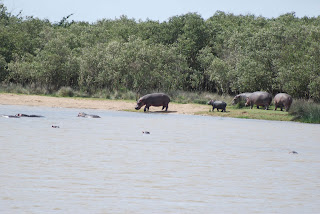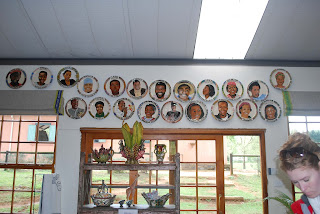 |
| Getting ready to board the boat for our tour |
 |
| Hippo walking on the bottom |
 |
| Crocodile sunning himself |
 |
| Hippos don't swim but walk on the bottom |
 |
| On a cool day the hippos like to be on land |
 |
| A new family of hippos |
 |
| Carol holding a hippo tooth |
 |
| Zebras |
 |
| Warthog |
 |
| Lions resting during the day |
 |
| View of the sweeping mountains and valleys of the park |
 |
| Female Nyala |
 |
| Elephant herd at dusk |
 |
| Rhino |
 |
| Lion at dusk |
 |
| Goliath Heron |
 |
| African Cape Buffalo |
KwaZulu Natal Tour - Day 1
September 19, 2016
We left Durban 8:00am Monday
with our guide, Greg Garson, in his nine passenger van for a two and one-half
hour drive north along the coast to the Saint Lucia Estuary, an inland wetlands
park that was once open to the ocean but which, since 2007 has been closed off,
due to climate change. The water part is home to around eight hundred hippos
and one thousand Nile crocodiles, as well as much other bird, and animal,
life. Once there we took a two hour boat ride on the shallow lake. We saw many
families of hippos along the way - a family consisting of one male and very
many females and offspring. Hippos don't swim, but walk on the lake or stand on
their hind legs, and it was fun to watch them appearing and disappearing in the
water. As sit was a rather cool day, many were also on land trying to soak up
whatever sun there was. We managed to spot a couple of crocodiles sunning
themselves as well, but mostly they were hidden in the water. In addition to
the hippos and crocs we saw African Fish Eagle, Goliath Heron and Egyptian
geese, Weaver birds, and some antelope
on shore. Since the time the wetlands area was closed to the ocean the salinity
of the water has reduced and the number of species residing there has decrease
by half. The boat captain was extremely well informed regarding the wetlands
and the animals and we enjoyed her narrative along the way.
Mid afternoon we continued to the Hluhluwe (pronounced
Shoeslouie) Game Reserve, a 964 square kim park established in part to help preserve
the rhino.It is owned by the people of South Africa and run by the South African Conservation Authority.
It is the oldest proclaimed game park in the country. In just the short 15 km
drive from the park entrance to Hilltop Camp, where we would be staying for two
days, we say rhinos, buffalo, and lions, three of the "big five! It was
awesome to see these animals in their own environment. Our guide, Greg, was
very knowledgeable and we learned a fair bit about their habits, and what else
we could expect to see.
After checking in to Hilltop
Camp and moving our gear to our rooms, a nice chalet with all the comforts of
home, at five pm we took a three hour tour in an open ten seater jeep through
the park with a local guide, Welcome. Before it got dark we had seen elephants,
our fourth of the "big five', as well as more rhino, waterbucks, nyalas, zebras
duiker and lions. As it grew dark we used two spotlights, one shining out each
side of the vehicle, to spot game. We were able to see bushbucks, impalas, bush
pigs, more nyalas, baboons and buffalo before heading back to the Camp for a
large buffet dinner.
The parkland is spectacular,
with vast valleys and long sloping hills.The mountains here are like very large
sweeping hills, however they are the remnants of the oldest mountains in the
world and have been worn down over many millions of years. Being the dry season there isn't a lot of high
grass growing so the animals are easier to see. We were fortunate that the rain
that we suffered through in Durban on
the weekend turned the vegetation up here green and the animals were loving it.
















































